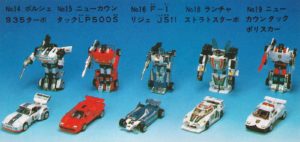In the mid-1980’s, the toy craze was in full swing. Hasbro had just launched their exceptionally successful G.I. Joe series and was determined to deliver new and innovative products to their loyal fans. With competitors like Mattel producing at the highest level, Hasbro was forced to ask themselves, what could possibly be next?
As it turned out, the answer was already in Japan. In 1983, Hasbro took notice of Japanese toy manufacturer Takara’s Microman and Diaclone toy lines — sets often credited with producing the original transforming robot toys.

The toys offered something new: modularity, an added degree of complexity and interaction for the user. In short — the Diaclone series created a different way to play. Hasbro was hooked. After purchasing the rights to produce the toys from Takara, the American toy manufacturer was ready to bring shape-shifting toys to North American markets.
One thing remained: a great marketing story that would bring the toys to life and make them irresistible for American kids. Hasbro had just worked with Marvel on a wildly successful three-pronged marketing strategy for their G.I. Joe franchise: a toy line, accompanied by a Marvel comic book and an animated series. Thus, with the help of Marvel’s Jim Shooter and Dennis O’Neill, the battle of the Autobots vs. Decepticons was written and the Transformers were born.
In 1984, Hasbro re-launched the Diaclone toy line under the name Transformers: Generation 1, turning the toys into recognizable characters such as Optimus Prime and Megatron. Just as they had done before, Marvel and Hasbro would co-produce a comic and animated series alongside the toy launch, boosting overall reception and popularity. Generation 1 (G1) would continue from 1984-1990, split up into individual series by year.
The original set of toys produced in 1984 falls under Series 1 (for those that are more familiar with trading cards, this is akin to a rookie card or 1st edition set). From a collector’s perspective, finding the earliest iterations of any collectable category tend to be the most valuable. In total, 28 characters were produced for Series 1: 18 Autobots and 10 decepticons. Optimus Prime, leader of the Autobots, quickly became the most popular character in the lineup.
As if getting your hands on one of the original 28 Transformers toys was not enough, Hasbro had another trick up their sleeve. While the shape-shifting robots were flying off shelves, a select few models from Series 1 were reserved for fans that were willing to put in a little extra effort.
That same year, Hasbro built another key marketing partnership with Pepsi to produce a limited edition toy that could not be purchased directly. In order to win the toy, fans would have to purchase select bottles and cans of Pepsi. For a lucky few, winning cans had the word “win” printed under the tab, while winning bottles would display a left or right image of Optimus Prime under the bottle cap. Both images needed to be collected in order to win. Then, and only then, would fans have the opportunity to own the Optimus Prime Pepsi edition toy.
Unbeknownst to anyone at the time, the budding Transformers series would go on to become a $14B franchise. Unlike many other series that produced toys to accompany a pre-existing show or series, the original toys in this case were the genesis of the Transformers story and are a pillar of collectable toy history.

